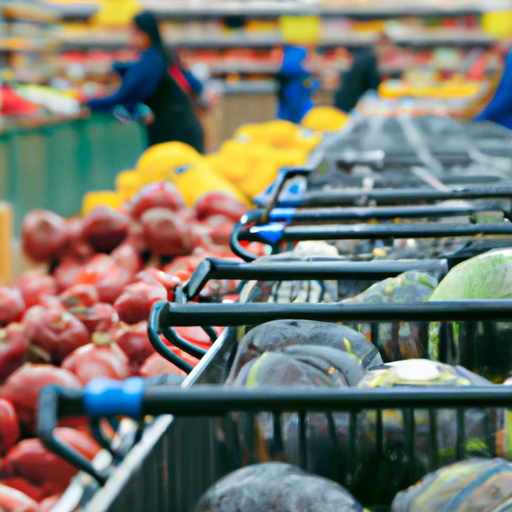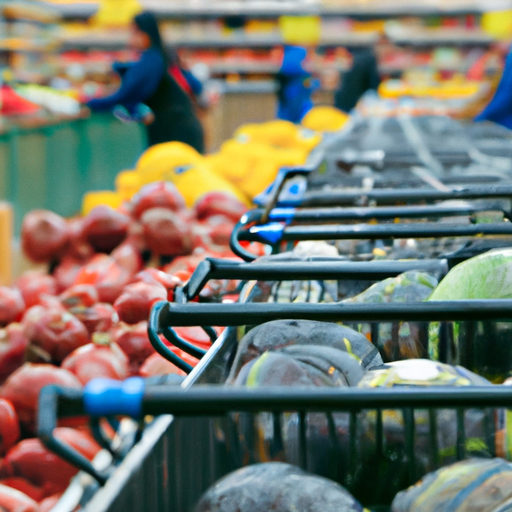Cpg Industry Trends
In this article, you will discover the latest trends shaping the CPG industry. From innovative product packaging to the rise of e-commerce, these trends are revolutionizing the way consumers interact with consumer packaged goods. Stay ahead of the game and explore the exciting developments that are reshaping the CPG landscape.

Table of Contents
E-commerce Growth
Increased online purchasing
In recent years, there has been a significant increase in online purchasing, with more and more people turning to the convenience of shopping from the comfort of their own homes. The rise of e-commerce giants like Amazon has played a significant role in this shift, offering a wide range of products and fast delivery options. Additionally, the COVID-19 pandemic has accelerated this trend, as people seek to minimize in-person interactions and prioritize safety.
Rise of direct-to-consumer brands
Another key trend in the e-commerce space is the rise of direct-to-consumer (D2C) brands. These brands bypass traditional retail channels and sell their products directly to consumers through their own websites or specialized online platforms. D2C brands have been able to thrive by leveraging digital marketing strategies, building a strong online presence, and establishing a direct relationship with their customers. This approach allows them to offer competitive pricing, better control over product quality, and personalized shopping experiences.
Growing popularity of subscription services
Subscription services have also gained significant popularity in the e-commerce industry. From meal kits and beauty boxes to clothing and pet supplies, consumers are embracing the convenience and surprise element that subscriptions offer. By signing up for a subscription service, customers can have products delivered to their doorstep on a regular basis without the hassle of reordering each time. This model not only allows for a more predictable revenue stream for businesses but also provides a more seamless and convenient shopping experience for consumers.
Digital Marketing Strategies
Shift towards influencer marketing
In recent years, there has been a notable shift towards influencer marketing in the digital marketing realm. Influencers, who have amassed a large following on social media platforms, have become powerful voices in promoting products and brands. Businesses are increasingly leveraging these influencers to endorse their products and reach their target audience in a more authentic and relatable way. Influencer marketing allows for product recommendations that stem from trusted sources, fostering credibility and driving consumer engagement.
Increased use of social media advertising
Social media platforms have become a key component of digital marketing strategies. With billions of users worldwide, platforms like Facebook, Instagram, and Twitter offer businesses the opportunity to target specific demographics, engage with consumers directly, and build brand awareness. Social media advertising allows for highly targeted campaigns, ensuring that businesses reach the right audience at the right time. From sponsored posts to interactive ads, social media platforms present a multitude of options for businesses to showcase their products and drive sales.
Personalized and targeted campaigns
In the age of digital marketing, businesses are increasingly focusing on personalized and targeted campaigns. By collecting and analyzing consumer data, businesses can gain valuable insights into consumer preferences, purchase patterns, and demographics. This data enables businesses to create tailored marketing campaigns that resonate with their target audience. Whether it’s personalized email marketing, customized recommendations, or targeted advertisements, delivering content that aligns with individual preferences results in higher engagement and conversion rates.
Product Innovation
Focus on healthier and natural products
One significant trend in the consumer packaged goods (CPG) industry is the increasing focus on healthier and natural products. Consumers are becoming more conscious of their health and wellness and are actively seeking products that align with their lifestyle choices. As a result, manufacturers are reformulating products to reduce artificial ingredients, additives, and preservatives while emphasizing natural and organic ingredients. This shift towards healthier options reflects the growing demand for products that promote overall well-being.
Introduction of plant-based alternatives
The introduction of plant-based alternatives has been a major disruptor in the CPG industry. As more individuals adopt vegetarian, vegan, or flexitarian diets, there has been a surge in plant-based alternatives to traditional animal-based products. Plant-based meats, dairy-free milk, and vegan snacks are just a few examples of the innovative products that have gained popularity. Manufacturers are investing in research and development to create plant-based options that not only mimic the taste and texture of traditional animal-based products but also provide the added benefit of being more sustainable and environmentally friendly.
Integration of technology in products
Technology continues to play a significant role in product innovation in the CPG industry. From smart appliances to wearable devices, the integration of technology has enhanced the functionality and convenience of consumer products. For example, smart home devices allow consumers to control and monitor their appliances remotely, while wearable fitness trackers provide real-time data on physical activity and health metrics. This integration of technology not only enhances the overall consumer experience but also opens up new avenues for data collection and analysis, enabling companies to further tailor their products to consumer needs.
Omnichannel Retailing
Integration of online and offline shopping experiences
Omnichannel retailing refers to the integration of online and offline shopping experiences, allowing consumers to seamlessly switch between different channels throughout their purchasing journey. Retailers now recognize the importance of providing a consistent experience across all touchpoints, including physical stores, websites, and mobile apps. This integration enables consumers to research products online, visit a physical store to see and touch items, and then make a purchase either in-store or online. The goal is to provide a flexible and convenient shopping experience that meets consumers’ preferences and accommodates their changing needs.
Use of mobile apps for seamless shopping
Mobile apps have revolutionized the way consumers interact with brands and make purchases. Retailers have recognized the potential of mobile apps as a powerful tool to engage with customers, drive sales, and enhance the overall shopping experience. Mobile apps provide a personalized and convenient platform for consumers to browse products, make purchases, track orders, and receive customized recommendations. They also enable retailers to leverage location-based services and send targeted promotions and notifications, further enhancing the customer experience.
Flexible delivery options
Flexibility in delivery options has become a key factor in meeting consumer expectations. With the rise of e-commerce, consumers now expect fast and convenient delivery services. Retailers are responding to this demand by offering flexible delivery options such as same-day delivery, next-day delivery, and click-and-collect services. These options provide consumers with the flexibility to choose the delivery method that suits their schedule and preferences. Additionally, some retailers are exploring alternative delivery methods such as drones and autonomous vehicles to further enhance speed and convenience.
Sustainability and Eco-Friendly Practices
Growing consumer demand for sustainable products
Consumers today are increasingly aware of the environmental impact of their purchasing decisions and are actively seeking sustainable products. They are looking for brands that prioritize eco-friendly practices, reduce their carbon footprint, and minimize waste. As a result, companies are investing in sustainable sourcing, using recyclable or biodegradable packaging materials, and implementing eco-friendly manufacturing processes. By aligning with consumer values and delivering sustainable products, companies can attract a growing market of environmentally conscious consumers.
Reducing packaging waste
One of the major challenges in the CPG industry is packaging waste. Consumers are becoming more vocal about their frustration with excessive packaging, single-use plastics, and non-recyclable materials. In response, companies are taking steps to reduce packaging waste by using eco-friendly materials, optimizing packaging design to minimize waste, and promoting the reuse or recycling of packaging components. Additionally, some companies have introduced innovative packaging solutions such as refillable containers and compostable packaging, further contributing to the reduction of packaging waste.
Implementing energy-efficient manufacturing processes
Sustainability in the CPG industry goes beyond product and packaging. Companies are also focusing on implementing energy-efficient manufacturing processes to minimize their environmental impact. From optimizing production lines to investing in renewable energy sources, manufacturers are finding innovative ways to reduce energy consumption and greenhouse gas emissions. These initiatives not only address environmental concerns but also lead to cost savings and operational efficiency. By adopting sustainable practices throughout the entire value chain, companies can meet consumer expectations, reduce their environmental footprint, and contribute to a greener future.
Changing Consumer Preferences
Increased focus on convenience and time-saving
In today’s fast-paced world, convenience and time-saving have become paramount for consumers. They seek products and services that simplify their lives, streamline their routines, and save them valuable time. As a result, companies are constantly innovating to offer products that cater to these preferences. From ready-to-eat meals and meal kits to time-saving gadgets and quick home delivery services, businesses are tapping into the demand for convenience and providing solutions that meet the needs of time-conscious consumers.
Preference for personalized shopping experiences
Personalization has become a ubiquitous trend in the consumer landscape, and shopping experiences are no exception. Consumers expect tailored recommendations, personalized offers, and customized shopping experiences that cater to their specific needs and preferences. To deliver on these expectations, businesses are leveraging data analytics and artificial intelligence to gain insights into consumer behavior and preferences. By understanding individual shopping habits and delivering personalized experiences across all touchpoints, companies can enhance customer satisfaction and drive loyalty.
Rise of conscious consumerism
Conscious consumerism is a growing movement where individuals prioritize purchasing decisions that align with their values and beliefs. Ethical sourcing, sustainability, social responsibility, and animal welfare are just a few of the factors that conscious consumers consider when making purchasing decisions. Companies, in response, are being held to higher standards and are expected to be transparent about their practices and values. This shift in consumer preferences presents an opportunity for businesses to differentiate themselves by promoting their commitment to social and environmental causes, fostering trust, and building a loyal customer base.
Data Analytics and AI
Utilization of big data for insights
The availability and abundance of data have revolutionized business operations, and the CPG industry is no exception. Companies are leveraging big data to gain valuable insights into consumer behavior, market trends, and product performance. By analyzing large sets of data, businesses can identify patterns, preferences, and opportunities. This data-driven approach allows for informed decision-making, targeted marketing campaigns, and product innovation that aligns with consumer needs and desires.
Predictive analytics for demand forecasting
Predictive analytics has become an essential tool for demand forecasting in the CPG industry. By analyzing historical data, market trends, and external factors, companies can make accurate predictions about future demand. This enables businesses to optimize their production and inventory management, ensuring that they meet consumer demand while minimizing stockouts and overstock situations. Predictive analytics also helps companies anticipate changes in consumer behavior and preferences, allowing for proactive decision-making and strategic planning.
Artificial intelligence in supply chain optimization
Artificial intelligence (AI) has enormous potential to revolutionize supply chain management in the CPG industry. AI-powered systems can analyze vast amounts of data, optimize inventory levels, and predict supply chain disruptions. By automating certain processes and providing real-time insights, AI can improve efficiency, reduce costs, and enhance overall supply chain performance. With advances in machine learning and predictive modeling, companies can identify areas for improvement and implement innovative solutions to streamline their supply chain operations.
Changing Retail Landscape
Expansion of online grocery shopping
The online grocery shopping sector has experienced significant growth in recent years. Consumers are increasingly embracing the convenience of ordering groceries online and having them delivered to their doorstep. The COVID-19 pandemic has further accelerated this trend, as people prioritize safety and minimize in-person interactions. As a result, retailers have been expanding their online grocery offerings, investing in infrastructure and technology to meet the growing demand. Online grocery shopping is not only convenient for consumers but also presents opportunities for retailers to capture a larger market share and leverage data-driven insights to personalize the shopping experience.
Growing dominance of Amazon and digital marketplaces
Amazon, the e-commerce giant, has established itself as a dominant force in the retail industry. With its vast product selection, competitive pricing, and efficient delivery services, Amazon has captured a significant market share and has disrupted traditional retail channels. Additionally, digital marketplaces like eBay and Alibaba have gained traction, offering consumers a wide range of products from various sellers. These digital marketplaces provide small businesses and independent sellers with an opportunity to reach a global customer base and compete with larger retailers. The growing dominance of these platforms has prompted traditional retailers to adopt e-commerce strategies and enhance their online presence.
Shift towards experiential retail
As online shopping continues to grow, traditional brick-and-mortar retailers are rethinking their strategies to stay relevant and attract customers. Experiential retail has emerged as a viable approach to engage consumers and create memorable in-store experiences. Retailers are transforming their physical spaces into immersive environments that go beyond traditional shopping. This includes interactive displays, pop-up events, product demonstrations, and personalized services. By providing an experience that online shopping cannot replicate, retailers can differentiate themselves and draw customers back into their stores.
Supply Chain Optimization
Efficient inventory management
Efficient inventory management is crucial for the success of CPG companies. By optimizing inventory levels, businesses can avoid stockouts, reduce carrying costs, and improve cash flow. Advanced inventory management systems, coupled with data analytics and demand forecasting, enable companies to make informed decisions regarding production, procurement, and distribution. This ensures that products are always available to meet consumer demand without excessive overstocking. Additionally, technologies like RFID and barcode scanning facilitate accurate tracking of inventory throughout the supply chain, minimizing errors and improving overall efficiency.
Fast and accurate order fulfillment
Order fulfillment is a critical aspect of the supply chain that directly impacts customer satisfaction. Consumers expect fast and accurate order processing, regardless of the channel they choose to purchase from. Companies are investing in automation and robotics to enhance order fulfillment processes, ensuring that orders are picked, packed, and shipped quickly and accurately. This not only improves customer satisfaction but also reduces operational costs and increases productivity. Additionally, real-time visibility of orders and shipments enables companies to proactively address any issues and provide timely updates to customers.
Improved transportation and logistics
Transportation and logistics play a crucial role in the CPG supply chain, ensuring that products are delivered to the right place at the right time. To optimize transportation and logistics, companies are leveraging technology and data analytics to improve route planning, minimize transportation costs, and enhance overall efficiency. This includes utilizing route optimization software, implementing real-time tracking systems, and adopting alternative transportation methods like rail or intermodal transportation. By continually reviewing and refining their transportation and logistics strategies, companies can reduce lead times, enhance order visibility, and provide reliable and timely delivery to customers.
Health and Wellness Trend
Focus on functional and fortified products
The health and wellness trend has led to an increased focus on functional and fortified products. Consumers are seeking products that not only provide basic nutrition but also offer additional health benefits. Functional foods and beverages are formulated with specific ingredients or nutrients that aim to improve health or prevent certain conditions. Fortified products, on the other hand, have nutrients added to them that may be lacking in the average diet. From probiotics and omega-3 fatty acids to vitamins and minerals, there is a growing demand for products that support overall health and well-being.
Increased demand for vitamins and supplements
Vitamins and supplements have seen a surge in demand as consumers prioritize their health and seek proactive ways to support their well-being. From multivitamins and minerals to specific supplements like vitamin D or omega-3, consumers are turning to these products to ensure they meet their recommended daily intake of essential nutrients. As a result, manufacturers are developing new formulations, exploring innovative delivery methods, and focusing on transparency and quality to meet the growing demand for vitamins and supplements.
Growth of health-conscious and fitness-oriented consumers
The health and wellness trend has also fostered the growth of health-conscious and fitness-oriented consumers. More people than ever are prioritizing regular exercise, healthy eating, and overall well-being. This shift in consumer behavior presents new opportunities for businesses to market products that cater to this health-conscious demographic. From fitness equipment and athleisure wear to organic foods and sports nutrition products, companies are capitalizing on the growing demand for products that support an active and healthy lifestyle.
In conclusion, the CPG industry is experiencing significant shifts and trends that are shaping the way companies operate and interact with consumers. With the growth of e-commerce, the rise of direct-to-consumer brands, and the increasing popularity of subscription services, businesses are adapting to meet the changing preferences of consumers. Digital marketing strategies, product innovation, and omnichannel retailing are enabling companies to engage with their target audience, personalize their offerings, and provide seamless shopping experiences. Sustainability and eco-friendly practices are becoming key considerations, as consumers demand more environmentally conscious products and practices. Data analytics, AI, and supply chain optimization are driving increased efficiency and enhancing decision-making processes. As the retail landscape evolves, businesses are exploring new avenues such as experiential retail and online grocery shopping. Finally, the health and wellness trend is influencing consumer preferences, leading to a focus on functional products, vitamins and supplements, and catering to health-conscious consumers. By understanding and embracing these industry trends, companies can position themselves for success in an ever-evolving and competitive market.






